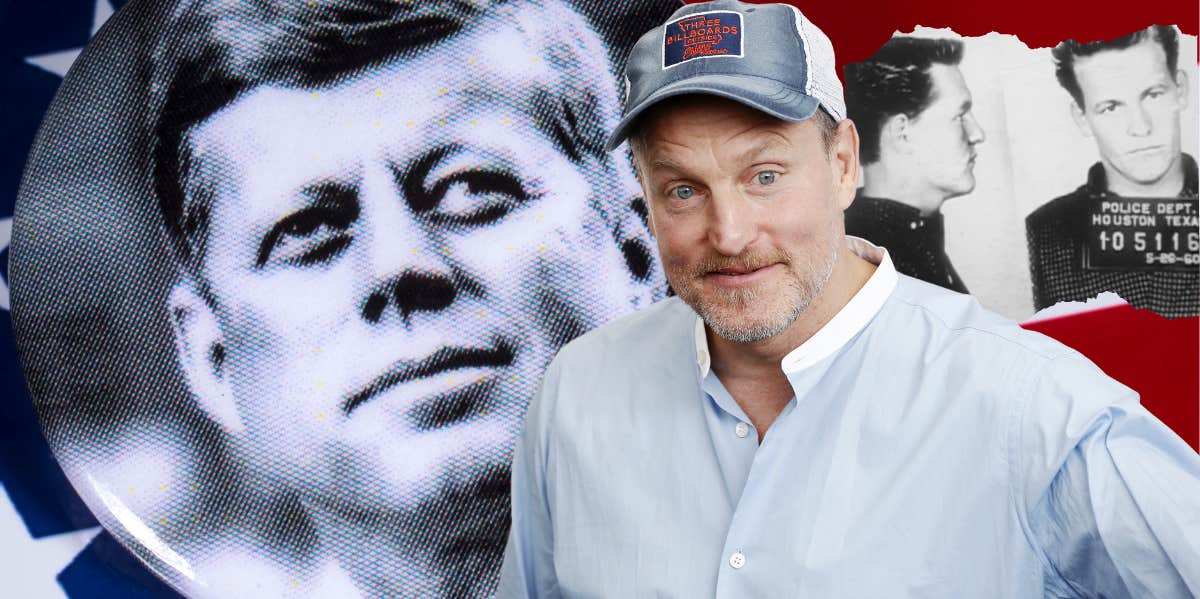Inside The Conspiracy Theory That Woody Harrelson's Dad Killed John F. Kennedy
He was a contract hitman convicted of two murders but claimed many more.
 Andrea Raffin, chrisdorney / Shutterstock & Wikimedia Commons
Andrea Raffin, chrisdorney / Shutterstock & Wikimedia Commons On November 22, 1963, the world stood still when President John F. Kennedy was assassinated in Dallas, Texas. Two years prior and roughly 300 miles away in the smaller city of Midland, Texas, Charles and Diane Harrelson’s world was also changed when they had their son, Woody Harrelson.
While Woody became a famous actor starring in classics like "Cheers" and "True Detective," Charles garnered a famous reputation of his own. He was a contract hitman who was first convicted for the 1968 assassination of grain dealer Sam Degelia Jr and was paid $2,000 for the murder. He was released after just five years for “good behavior.”
Then in 1979, drug smuggler Jamiel Sagra coughed up a lot more for him to carry out the first murder of a sitting U.S. federal judge, John H. Wood Jr, known as “Maximum John” for his severe sentencing of drug traffickers. Sagra paid Charles $250,000, the equivalent of over $1.2 million today, to make sure the judge set to determine his fate would never preside over another case again.
In September 1980, Charles was high on cocaine when he engaged in a six-hour standoff with the police over the killing. It was during that when he confessed not only that he had killed the judge but also JFK. And thus, the theory was born.
RELATED: Inside JFK’s Intimate Relationship With Gay Best Friend Who Had His Own Room In The White House
Did Woody Harrelson’s dad Charles Harrelson kill JFK?
So, is there any proof that Charles had a hand in the infamous assassination? Next to the building that Lee Harvey Oswald shot him from and mere hours after the tragedy, several Texas newspapers photographed police escorting three men. They later became known as the “three tramps.”
According to the author and prosecutor Vincent Bugliosi’s book, "Reclaiming History: The Assassination of President John F. Kennedy," conspiracy theorist Richard E. Sprague was the first to uncover the forgotten photographs of the “three tramps.” He subsequently turned them over to attorney Jim Garrison who made it famous when he showed them to the world during a 1968 appearance on Johnny Carson’s "The Tonight Show," suggesting they had something to do with the plot.
Soon people started to speculate who exactly these three homeless arrestees were.
Some theories claimed that Frank Sturgis was one of the three, also known as part of the five perpetrators of the Watergate burglary. Others postulated that one of the men was E. Howard Hunt. Hunt was a former CIA officer who was part of Nixon’s secretive team to contain leaks and, before that, had a hand in the U.S.-backed coups in Latin America like the failed Bay of Pigs.
Conspiracy theorist Jim Marrs was one of the first to popularly hypothesize that perhaps Charles was one of the men. He claimed that the tallest and youngest of the three resembled him. The theory got some legs when Lois Gibson offered her expertise. Gibson had secured over 1,000 convictions for her work and was dubbed “the world’s most successful forensic artist” by the Guinness World Records in 2017. She used side-by-side images of the two men, comparing their facial structures to assert that they were the same person.
So, Charles being a Texas native, a famed hitman and bearing a resemblance to one of the men all made this theory incredibly juicy.
However, Charles eventually went back on his claim.
In a Dallas television interview soon after his capture, Charles gave why he said during the standoff that he was involved in the JFK assassination plot.
“At the same time I said I had killed the judge, I said I had killed Kennedy, which might give you an idea to the state of my mind at the time,” he said. “It was an effort to elongate my life.”
On top of that, in 1992, journalist Mary La Fontaine identified the three men using arrest records as Gus Abrams, Harold Doyle and John Gedney, who police took from a railroad car near the assassination site, according to Bugliosi.
Charles spent the remainder of his life behind bars due to the killing of the district judge. Though Woody visited him multiple times, describing their relationship more as friends than father and son because of his absence in his childhood. So, for now, the conspiracy remains just that. Maybe one day we’ll get a movie with Woody playing his father because the stories of his that are confirmed are—almost—as wild.
Ethan Cotler is a writer living in Boston. He writes on entertainment and news.

